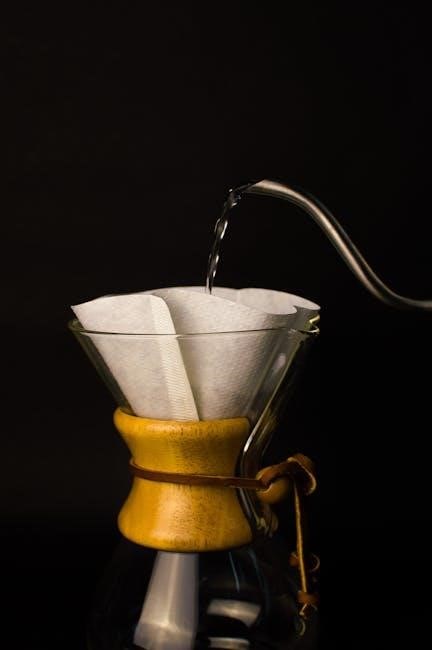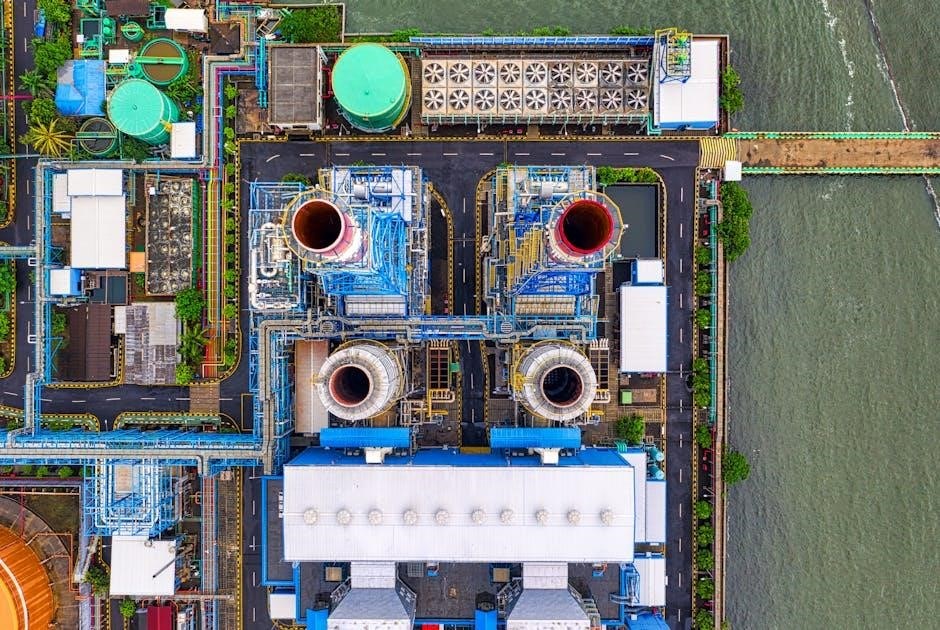Welcome to the Midea Hot Water System Manual. This guide provides essential information for safe installation, operation, and maintenance of your water heater. Read carefully to ensure optimal performance and compliance with AS/NZS 3500.4 standards.
1.1 Overview of the Midea Hot Water System
The Midea Hot Water System is designed for efficient and reliable performance, offering instantaneous heating for endless hot water supply. It features advanced heat pump technology, providing up to 3:1 energy efficiency. Suitable for household use, it can be installed indoors where hot water is needed. The system requires direct connection to a circuit breaker and complies with AS/NZS 3500.4 standards. It includes temperature control, smart monitoring, and safety features for optimal performance and user convenience.
1.2 Importance of Reading the Manual
Reading the Midea Hot Water System Manual is crucial for safe and efficient operation. It provides detailed instructions on installation, maintenance, and troubleshooting, ensuring compliance with safety standards like AS/NZS 3500.4. The manual highlights essential precautions to avoid scalding and system damage, while also guiding users on eco-friendly practices and proper disposal of old units. Understanding the manual helps maximize energy efficiency and extends the system’s lifespan.

Safety Precautions
Adhering to safety guidelines is essential for safe system operation. Always follow warning notices and ensure proper installation to prevent accidents. Regularly inspect safety devices and ensure emergency shutdown procedures are understood. Preventive measures protect both users and the system from potential hazards, ensuring reliable and secure operation at all times.
2.1 Warning Notices and Safety Indicators
Warning notices and safety indicators are crucial for ensuring safe operation. These notices highlight potential hazards, such as scalding risks or electrical dangers. Safety indicators, including lights or alarms, alert users to system malfunctions. Always heed these warnings to prevent accidents. Ignoring them could lead to burns, electrical shocks, or system damage. Familiarize yourself with all indicators and consult the manual for proper interpretation and response to ensure safe usage and maintenance of the system.
2.2 Handling Hot Water Safely
Always handle hot water with care to avoid burns. Before use, test the temperature by hand or with a thermometer. Avoid direct contact with water above 50°C, as it can cause scalding. Mix hot and cold water thoroughly, especially for vulnerable users like children. Never leave running hot water unattended, and ensure the system is set to a safe temperature to prevent accidents and energy waste.
2.3 Precautions to Avoid Scalding
To prevent scalding, set the water heater temperature between 40°C and 50°C. Use a thermostatic mixing valve to regulate water temperature safely. Always test water temperature before use, especially for children or the elderly. Avoid direct contact with hot water outlets, and never leave running hot water unattended. Ensure all users understand the risks of high temperatures and take precautions to avoid accidental burns.

Installation Guidelines
Ensure the Midea hot water system is installed by a qualified professional, adhering to local plumbing codes and manufacturer specifications for safe and efficient operation.
3.1 Step-by-Step Installation Process
- Prepare the installation site, ensuring it is level and meets local regulations.
- Unpack and inspect the unit for damage or defects.
- Place the water heater in the designated area, ensuring proper ventilation.
- Connect the inlet and outlet pipes according to the manual’s specifications.
- Install electrical connections, adhering to safety standards and power requirements.
- Test the system for leaks and proper function before finalizing the setup.
3.2 Plumbing Connections and Requirements
Ensure all plumbing connections are made with approved materials and comply with local regulations. Use correctly sized pipes to maintain water pressure and flow rates. Install isolation valves for easy maintenance access. Connect the cold water inlet and hot water outlet according to the manual’s diagrams. Ensure proper backflow prevention devices are in place to protect the water supply. Follow AS/NZS 3500.4 standards for safe and reliable installation.
3.3 Electrical Connections and Power Supply
Ensure all electrical connections are performed by a licensed electrician. Use a power supply that matches the system’s voltage rating (220-240V AC). Install a dedicated circuit with a suitable circuit breaker. Connect the system according to the wiring diagram in the manual. Use appropriately sized cables to avoid overheating. Ensure proper earthing for safety and to prevent electric shock. Refer to local electrical standards for compliance. Always turn off power before servicing.
3.4 Compliance with Local Plumbing Codes (e.g., AS/NZS 3500.4)
Ensure the Midea hot water system installation complies with AS/NZS 3500.4 and local plumbing regulations. Use approved materials for water heating and distribution. Install temperature and pressure relief valves as specified. Ensure proper pipe sizing, insulation, and drainage. Regular inspections by licensed plumbers are essential. Maintain records of compliance for certification. Non-compliance may result in safety risks or legal issues. Always follow local authority requirements for water heating systems.

Operating Instructions
This section provides step-by-step instructions for operating the Midea hot water system. Learn how to turn on the heater, adjust settings, and monitor performance for safe and efficient operation.
4.1 Turning On the Water Heater
To start the Midea hot water system, ensure the power supply is connected and switch on the unit. Press the power button on the control panel and confirm activation via the indicator light or sound. Allow the system to complete its initial heating cycle. Always ensure safety by checking for proper electrical connections and no gas leaks before operation. Refer to the troubleshooting section if the heater does not activate.
4.2 Adjusting Water Temperature Settings
To adjust the water temperature on your Midea hot water system, access the control panel and locate the temperature adjustment buttons. Use the “+” or “-” buttons to set your desired temperature, then press “SET” to save; Ensure the temperature is within the recommended range (40°C to 80°C) for safety and efficiency. Avoid excessively high settings to prevent scalding and reduce energy consumption. Always refer to the manual for detailed guidance.
4.3 Understanding the Heating Cycle
The Midea hot water system operates on a heating cycle that automatically maintains your set temperature. When the thermostat detects a drop in water temperature, the heating element activates to warm the water. Once the desired temperature is reached, the system enters standby mode. This cycle ensures efficient energy use and consistent hot water supply while preventing overheating. Regular monitoring helps optimize performance and safety.
4.4 Monitoring the System Indicator
The system indicator on your Midea hot water system provides real-time status updates. It displays whether the system is actively heating, in standby mode, or if an error has occurred. Regularly checking the indicator helps ensure optimal performance and allows for prompt troubleshooting. The LED lights or digital display will alert you to variations in operation, enabling you to address issues before they affect your hot water supply.
Maintenance and Care
Regular maintenance ensures optimal performance and extends the lifespan of your Midea hot water system. Always check for wear, clean components, and follow a routine schedule.
5.1 Cleaning the Water Heater
Regular cleaning is essential to maintain efficiency and prevent mineral buildup. Turn off power and water supply before starting. Drain the tank and use a soft brush or non-abrasive cleaner to remove debris. Avoid harsh chemicals to prevent damage. Rinse thoroughly and refill the tank after cleaning. Regular descaling is recommended in hard-water areas to ensure optimal performance and longevity of the system. Always follow manufacturer guidelines for cleaning products.
5.2 Draining and Flushing the System
Draining and flushing are crucial for removing sediment and maintaining efficiency. Turn off power and water supply, then attach a garden hose to the drain valve. Direct water to a drain or bucket. Flush the system with clean water until it runs clear. Repeat if sediment is heavy. Regular flushing every 6–12 months prevents buildup and ensures optimal performance. Always follow safety precautions during this process.
5.3 Checking for Leaks and Damage
Regularly inspect the system for leaks or damage to ensure reliability. Visually examine pipes, connections, and valves for water droplets or stains. Use soapsuds or leak-detection sprays on pressurized parts to identify hidden leaks. Turn off power and water supply before inspections. Check the temperature and pressure relief valve for proper function. Address any issues promptly to prevent further damage. Schedule professional inspections annually for optimal performance and safety.
5.4 Recommended Maintenance Schedule
To ensure optimal performance, follow a regular maintenance schedule. Check and clean the filter monthly to prevent blockages. Every six months, inspect and clean the heating element and anode rod. Annually, drain and flush the tank to remove sediment. Schedule a professional service to check electrical and plumbing connections. Replace worn-out parts promptly to avoid system failure. Regular maintenance ensures efficiency, longevity, and safe operation of your Midea hot water system.

Troubleshooting Common Issues
This section provides guidance for diagnosing and resolving common problems, ensuring your Midea hot water system operates efficiently and safely. Address issues promptly to prevent further complications.
6.1 No Hot Water or Insufficient Heat
If your Midea hot water system isn’t producing heat or the water is too cold, check the power supply and ensure the thermostat is set correctly. Verify that the heating elements are functioning and there are no issues with the gas supply (if applicable). Restart the system after addressing any identified problems. Consult a professional if the issue persists to avoid further complications.
6.2 Leakage from the System
If you notice water leakage from your Midea hot water system, turn off the power and water supply immediately. Inspect the connections, valves, and pipes for any damage or looseness. Tighten any loose fittings and replace worn-out gaskets or seals. If the leak persists, contact a licensed plumber to avoid water damage and ensure safety. Regular maintenance can help prevent such issues.
6.3 Error Codes and Service Indicators
If your Midea hot water system displays error codes or service indicators, refer to the manual for specific code meanings. Common codes like E1 or E2 indicate issues such as sensor malfunctions or heating element problems. Check the LED indicators on the control panel for fault status. Reset the system if instructed or contact Midea customer support for professional assistance. Always ensure proper diagnosis to avoid further damage. Regular checks can prevent such issues.
6.4 Restarting the System After Power Outage
After a power outage, ensure the Midea hot water system is restarted correctly. Check the control panel for any error codes or indicators. If the system does not automatically restart, press the reset button or switch the power off and on. Allow a few minutes for the system to resume operation. Ensure all connections are secure and functioning properly. If issues persist, consult the manual or contact Midea customer support for assistance.

Energy Efficiency and Cost Savings
Midea hot water systems are designed to minimize energy consumption, reducing utility bills while maintaining optimal performance. Eco-friendly technologies ensure efficient operation, lowering costs and environmental impact.
7.1 Understanding Energy Efficiency Ratings
Energy efficiency ratings are crucial for evaluating the performance of your Midea hot water system. These ratings indicate how efficiently the system converts energy into heat, reducing energy waste. Higher ratings mean lower energy consumption and costs. Midea systems often feature advanced technologies like heat pumps, which boost efficiency. Understanding these ratings helps you make informed decisions to save money and reduce your environmental footprint. Always look for certifications like Energy Star for optimal efficiency.
7.2 Tips for Reducing Energy Consumption
To minimize energy usage, lower the temperature setting to around 60°C for general use. Install a timer to operate the system only during peak demand periods. Regularly inspect and maintain insulation to reduce heat loss. Fix leaks promptly to avoid wasting hot water. Consider using off-peak electricity for heating, and ensure the system is sized correctly for your household needs. These practices save energy and lower utility bills.
7.3 Benefits of Heat Pump Technology
‘ in the ‘midea hot water system manual’. The instructions say to always use exactly , no more, no less. I also need to make sure not to include any information that’s covered in other subheadings.
First, I should think about what heat pump technology is and its benefits. Heat pumps are known for being energy efficient because they transfer heat from one location to another instead of generating heat from fuel. This makes them more environmentally friendly compared to traditional systems that burn fossil fuels.
I should mention the energy efficiency aspect because that’s a key benefit. Maybe something like “Heat pump technology offers exceptional energy efficiency by transferring heat rather than generating it from fuel.” That’s a good start.
Next, environmental benefits are important. Since heat pumps use less energy and don’t burn fossil fuels, they reduce greenhouse gas emissions. So I could add a sentence about that: “This reduces greenhouse gas emissions and minimizes environmental impact.”
Cost savings are another significant advantage. Users would be interested to know that using a heat pump can lower their utility bills. I’ll include something like “By lowering energy consumption, it significantly reduces utility bills over time.”
Reliability is also a benefit. Heat pumps generally have a longer lifespan and require less maintenance compared to traditional systems. So, “Additionally, heat pumps often require less maintenance and have a longer lifespan than traditional water heaters.”
Finally, mentioning government incentives could be useful. Many governments offer rebates or tax credits for installing energy-efficient systems like heat pumps. So I can add, “Some governments also offer rebates or tax credits for installing heat pump systems, further enhancing their cost-effectiveness.”
“Heat pump technology offers exceptional energy efficiency by transferring heat rather than generating it from fuel. This reduces greenhouse gas emissions and minimizes environmental impact. By lowering energy consumption, it significantly reduces utility bills over time. Additionally, heat pumps often require less maintenance and have a longer lifespan than traditional water heaters. Some governments also offer rebates or tax credits for installing heat pump systems, further enhancing their cost-effectiveness.”
Let me check the word count:
Heat
pump
technology
offers
exceptional
energy
efficiency
by
transferring
heat
rather
than
generating
it
from
fuel
This
reduces
greenhouse
gas
emissions
and
minimizes
environmental
impact
By
lowering
energy
consumption
it
significantly
reduces
utility
bills
over
time
Additionally
heat
pumps
often
require
less
maintenance
and
have
a
longer
lifespan
than
traditional
water
heaters
Some
governments
also
offer
rebates
or
tax
credits
for
installing
heat
pump
systems
further
enhancing
their
cost-effectiveness
Oh, it’s . I need to remove one word to make it exactly 68. Maybe I can remove “further” to make it “enhancing their cost-effectiveness.”
Let me revise that part:
“Some governments also offer rebates or tax credits for installing heat pump systems, enhancing their cost-effectiveness.”
Now, let’s recount:
Heat
pump
technology
offers
exceptional
energy
efficiency
by
transferring
heat
rather
than
generating
it
from
fuel
This
reduces
greenhouse
gas
emissions
and
minimizes
environmental
impact
By
lowering
energy
consumption
it
significantly
reduces
utility
bills
over
time
Additionally
heat
pumps
often
require
less
maintenance
and
have
a
longer
lifespan
than
traditional
water
heaters
Some
governments
also
offer
rebates
or
tax
credits
for
installing
heat
pump
systems
enhancing
their
cost-effectiveness
Heat pump technology offers exceptional energy efficiency by transferring heat rather than generating it from fuel. This reduces greenhouse gas emissions and minimizes environmental impact. By lowering energy consumption, it significantly reduces utility bills over time. Additionally, heat pumps often require less maintenance and have a longer lifespan than traditional water heaters. Some governments also offer rebates or tax credits for installing heat pump systems, enhancing their cost-effectiveness.

Advanced Features of Midea Hot Water Systems
Midea systems offer smart controls for remote monitoring and temperature adjustments. They feature high-efficiency heat pumps and thermostatic valves for optimal performance. Advanced safety includes scald protection.
8.1 Temperature Control and Thermostatic Mixing Valves
Midea hot water systems feature advanced temperature control, allowing precise adjustments for optimal comfort. Thermostatic mixing valves ensure safe water temperatures, preventing scalding. These valves blend hot and cold water to a preset level, maintaining consistency. Digital controls enable easy temperature adjustments, while anti-scald protection enhances safety. This system is designed to meet varying household needs, providing efficient and reliable hot water delivery.
8.2 Heat Pump Technology for Maximum Efficiency
Midea hot water systems utilize advanced heat pump technology to achieve exceptional energy efficiency. By transferring heat from ambient air to water, these systems significantly reduce energy consumption. With a high coefficient of performance (COP), they provide substantial cost savings. Heat pump technology minimizes greenhouse gas emissions, making it an eco-friendly choice. This innovative approach ensures reliable hot water delivery while lowering utility bills and environmental impact, meeting modern demands for efficient solutions.
8.3 Smart Controls and Remote Monitoring
Midea hot water systems feature advanced smart controls, enabling users to monitor and manage their water heating remotely via a smartphone app. This technology allows for scheduling, temperature adjustments, and real-time energy tracking. Remote monitoring ensures optimal performance and energy efficiency. Smart controls also provide notifications for maintenance or issues, enhancing convenience and system reliability. Compatible with smart home systems, these features offer seamless integration and modern convenience for users.

Compliance and Certifications
Midea hot water systems comply with Australian and international standards, ensuring safety, efficiency, and environmental responsibility.
9.1 Australian Standards Compliance (AS/NZS 3500.4)
Midea hot water systems are designed to meet AS/NZS 3500.4 standards, ensuring compliance with Australian plumbing and drainage regulations. These standards cover design, installation, and performance requirements for water heating systems. Compliance guarantees safety, efficiency, and reliability, adhering to strict quality benchmarks; The system’s materials and components are tested to meet these criteria, ensuring durability and adherence to Australian safety and environmental standards. This certification provides assurance of a product that meets local regulatory expectations.
9.2 International Certifications and Approvals
Midea hot water systems are certified to meet global standards, ensuring reliability and safety. They comply with international certifications such as ISO, CE, and UL, ensuring adherence to global quality and safety benchmarks. These approvals verify the system’s performance, energy efficiency, and environmental sustainability, making them suitable for various international markets. This recognition ensures that Midea systems meet diverse regulatory requirements worldwide, providing users with trusted and reliable solutions.
Environmental Considerations
Midea hot water systems are designed with eco-friendly materials and energy-efficient technology to minimize environmental impact. They promote sustainable water and energy use, aligning with global green initiatives.
10.1 Eco-Friendly Design and Operation
Midea hot water systems feature eco-friendly designs that prioritize energy efficiency and sustainable operation. By utilizing advanced heat pump technology, these systems reduce energy consumption and lower carbon emissions. The units are constructed with recyclable materials, minimizing environmental impact during production and disposal. Additionally, smart temperature controls optimize water heating, reducing wasted energy and promoting water conservation. These eco-conscious features make Midea systems a responsible choice for environmentally aware consumers.
10.2 Proper Disposal of Old Units
Proper disposal of old Midea hot water systems is crucial for environmental protection. Always follow local regulations and guidelines for appliance disposal. Do not dump units in landfills, as they may contain hazardous materials. Recycle whenever possible by contacting certified e-waste recycling centers or participating retailers. Ensure all harmful substances, like refrigerants, are safely extracted by professionals. Responsible disposal helps conserve resources and reduce environmental impact.

Warranty and Customer Support
Midea offers a comprehensive warranty program with specific terms and conditions. For assistance, contact customer service via phone, email, or visit the official website for support and resources;
11.1 Warranty Terms and Conditions
Midea hot water systems are backed by a limited warranty covering parts and labor for a specified period. The warranty applies to defects in materials and workmanship under normal use. Registration within 30 days of installation is required for coverage. Terms vary by region and product model. Conditions may exclude damage caused by improper installation, misuse, or failure to maintain the system. Always refer to the warranty document for full details and exclusions.
11.2 Contacting Midea Customer Service
For inquiries, assistance, or service requests, contact Midea Customer Service via phone, email, or the official website. Support is available during business hours, Monday to Friday. Visit the Midea website for regional contact details. Ensure to have your product model number and purchase date ready for faster assistance. Warranty claims and technical support require proof of purchase and proper registration.

Additional Resources
The Midea Hot Water System Manual provides additional resources, including downloadable PDF manuals, online troubleshooting guides, and video tutorials for installation and maintenance support.
12.1 Downloading the Full Manual
The full Midea Hot Water System Manual can be downloaded from the official Midea website or through the product’s dedicated support page. Ensure you select the correct model to access accurate information. The manual is available in PDF format, making it easy to save and print for future reference. It includes detailed instructions for installation, operation, and troubleshooting, ensuring comprehensive guidance for optimal system performance and maintenance. Always verify the source for authenticity and updated content.
12.2 Online Troubleshooting Guides
Midea provides online troubleshooting guides to help users resolve common issues quickly. These guides are accessible through the official Midea website or support portal and are tailored to specific models. They include step-by-step solutions, error code explanations, and DIY repair tips. Users can search by symptom or error code for precise guidance, reducing downtime and the need for professional assistance. Regularly updated, these resources ensure accurate and reliable support for maintaining your hot water system efficiently.
12.3 Video Tutorials and Installation Guides
Midea offers video tutorials and detailed installation guides to simplify setup and operation. These resources, available on the official Midea website or YouTube, provide visual step-by-step instructions for installing, maintaining, and troubleshooting your hot water system. They cover topics like initial setup, temperature adjustments, and error resolution, ensuring users can confidently manage their system without professional help. Regular updates keep the content relevant and user-friendly.


